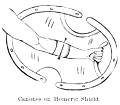Canon
(
κανών). A word probably derived from
κάννα, “a reed,” and properly meaning a straight rod. Its
special applications are as follows:
1.
In the Homeric shield, the
κανόνες are the bars to which
the shoulder-belt (
τελαμών) was at
 |
|
Canones on Homeric Shield.
|
tached; or two parallel bars used as handles, through one of which the warrior
placed his arm while he grasped the other. See the accompanying illustration.
2.
In weaving, a straight round rod to which the alternate threads of the warp were attached
by means of strings having loops at each end, one loop fastening the string to the
κανών, the other fastening it to the warp. This arrangement of
strings and loops was called
μίτος by the Greeks and
licia by the Romans.
3.
A carpenter's rule, much like our own. See
Regula.
4.
The beam of a balance, more often called
ζυγόν
(
Anth. Pal. xi. 334).
5.
Horizontal curtain-poles of silver-gilt (
Chares ap. Athen. 538 d).
6.
In a figurative sense,
κανών came to be used for whatever
served as a rule, model, or norm. Thus, of grammatical rules (Auson.
Epigr. 136), of the laws of style (
Ad Fam. xvi. 17, 1),
of logical tests of truth (
Diog. Laert. x. 27), and of the rules
of sculpture (Galen. iv. 354-355 Kühn).
7.
In the fiscal affairs of the later Empire,
canon was used of the
regular payments of tribute, especially of corn sent to the capital (
Cod. Th.
xiv. 15, 3).





